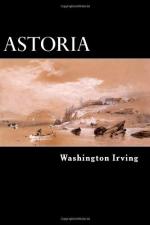In the centre was a singular lodge one hundred and fifty feet in circumference, supported by the trunks of twenty trees, about twelve inches in diameter and forty-four feet long. Across these were laid branches of pine and willow trees, so as to yield a tolerable shade. At the west end, immediately opposite to the door, three bodies lay interred with their feet towards the east. At the head of each was a branch of red cedar firmly planted in the ground. At the foot was a large buffalo’s skull, painted black. Savage ornaments were suspended in various parts of the edifice, and a great number of children’s moccasins. From the magnitude of this building, and the time and labor that must have been expended in erecting it, the bodies which it contained were probably those of noted warriors and hunters.
The next day, October 17th, they passed two large tributary streams of the Spanish River. They took their rise in the Wind River Mountains, which ranged along to the east, stupendously high and rugged, composed of vast masses of black rock, almost destitute of wood, and covered in many places with snow. This day they saw a few buffalo bulls, and some antelopes, but could not kill any; and their stock of provisions began to grow scanty as well as poor.
On the 18th, after crossing a mountain ridge, and traversing a plain, they waded one of the branches of Spanish River, and on ascending its bank, met with about a hundred and thirty Snake Indians. They were friendly in their demeanor, and conducted them to their encampment, which was about three miles distant. It consisted of about forty wigwams, constructed principally of pine branches. The Snakes, like most of their nation, were very poor; the marauding Crows, in their late excursion through the country, had picked this unlucky band to the very bone, carrying off their horses, several of their squaws, and most of their effects. In spite of their poverty, they were hospitable in the extreme, and made the hungry strangers welcome to their cabins. A few trinkets procured from them a supply of buffalo meat, and of leather for moccasins, of which the party were greatly in need. The most valuable prize obtained from them, however, was a horse; it was a sorry old animal in truth, but it was the only one that remained to the poor fellows, after the fell swoop of the Crows; yet this they were prevailed upon to part with to their guests for a pistol, an axe, a knife, and a few other trifling articles.
They had doleful stories to tell of the Crows, who were encamped on a river at no great distance to the east, and were in such force that they dared not venture to seek any satisfaction for their outrages, or to get back a horse or squaw. They endeavored to excite the indignation of their visitors by accounts of robberies and murders committed on lonely white hunters and trappers by Crows and Blackfeet. Some of these were exaggerations of the outrages already mentioned, sustained by some of the scattered members




